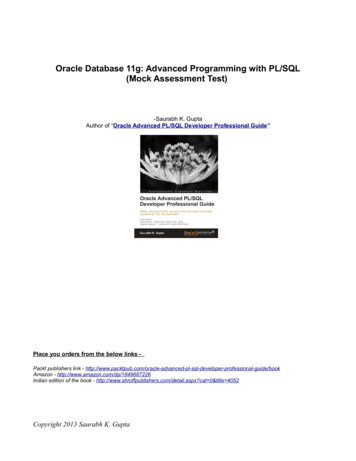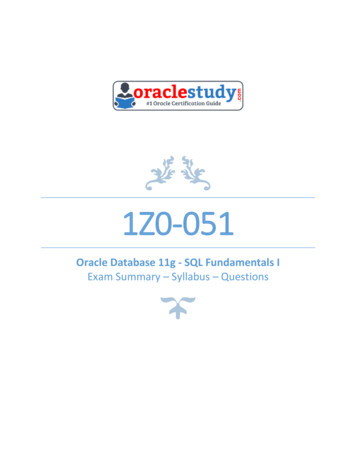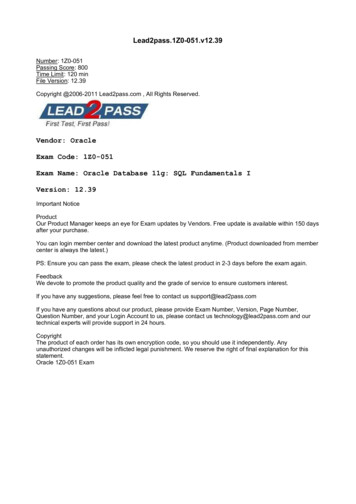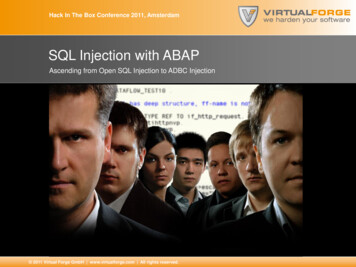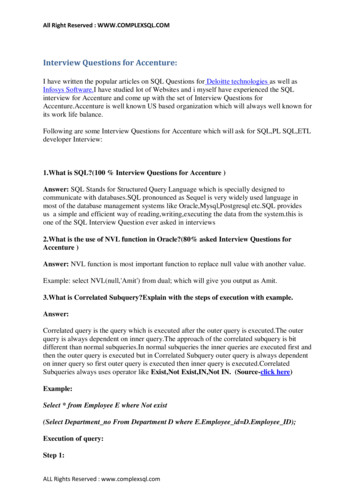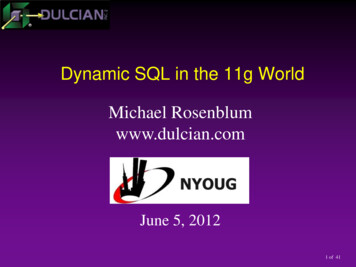
Transcription
Dynamic SQL in the 11g WorldMichael Rosenblumwww.dulcian.comJune 5, 20121 of 41
Who Am I? – “Misha” OracleACE Co-author of 2 books PL/SQLfor Dummies Expert PL/SQL Practices WonODTUG 2009 Speaker of the Year Known for: SQLand PL/SQL tuning Complex functionality Code generatorsRepository-based development2 of 41
Why am I giving thispresentation? – Because SQL is my favorite toy – and I like totalk about it! Dynamic2007 – Dynamic SQL in Dynamic World ODTUG 2008 – Dynamic SQL: The Sequel Expert PL/SQL Practices, Apress, 2011 – Chapter 2 ODTUG Developersare still uncomfortable withDynamic SQL. Thereare many myths and misunderstandingsfloating around. Majority So,of people are (finally!) using 11git is time to give an 11g-only presentation.3 of 41
Just to make sure that we areon the same page 4 of 41
The Hero DynamicSQL: Makesit possible to build and process complete SQLand PL/SQL statements as strings at runtime.5 of 41
Dynamic SQL Core About90% of Dynamic SQL is covered by a singlecommand (with variations):declarev var varchar2(N) CLOB;beginv var: 'whatever you want';EXECUTE IMMEDIATE v var;end;ORbeginEXECUTE IMMEDIATE 'whatever you want';end;6 of 41
Dynamic Cursors Syntaxdeclarev cur SYS REFCURSOR;v sql varchar2(N) CLOB: .v rec .%rowtype; -- or record typebeginopen v cur for v sql tx;fetch v cur into v rec;close v cur;end; Mostcommon use: Processinglarge datasets with unknown structure7 of 41
DBMS SQL PackagePredecessor of Native Dynamic SQL Pros: Separates PARSE and EXECUTEThe same query can be reused with different bind variables. Workswith unknown number/type ofINPUT/OUTPUT values Cons: Significantlyslower More difficult to use8 of 41
11g-Only Features9 of 41
Agenda Supportof CLOBs in Native Dynamic SQL Cursor transformation No datatype restrictions for DBMS SQL DBMS SQLnow is a complete superset of NativeDynamic SQL DBMS ASSERTis official now. Nice-to-have: Betterintegration On-the-fly wrapper10 of 41
CLOB as Input Goodnews: EXECUTE Badnews: You IMMEDIATE can take CLOB.need to know how to properly use CLOBs.Concatenation is not such a good idea! Ifyou need to build an on-the-fly PL/SQL object 32Kthere may be something wrong with this picture But it may also be OK (I personally have used these!)11 of 41
Building a Query - 1function f BuildQuery CL (in tab tx varchar2)return CLOB isv out cl CLOB;v break tx varchar2(4): ' BR ';v hasErrors yn varchar2(1): 'N';v buffer tx varchar2(32767);procedure p flush isbegindbms lob.writeappend(v out cl,length(v buffer tx), v buffer tx);v buffer tx: null;end;procedure p addToClob (in tx varchar2) isbeginif length(in tx) length(v buffer tx) 32767 thenp flush;end if;v buffer tx: v buffer tx in tx;12 of 41end;
Building a Query - 2Begindbms lob.createtemporary(v out cl,true,dbms lob.Call);p addToClob('create or replace view V ' in tab tx ' as select ROWNUM num rows');for rec rep in (select * from my tab colwhere table name in tab tx)loopp addToClob(',' rec rep.column tx);end loop;.p addToClob(' from ' in tab tx);p flush; -- write leftoversreturn v out cl;end;13 of 41
Dynamic Wrapper DBMS DDLpackage WRAP CREATE WRAPPED Whatdoes it do? Objects (wrap Execute Immediate)are created and wrapped on the fly.This is a really good idea for repository-based systems.This feature was introduced long ago, but I only recentlydiscovered it. Unfortunatelyit does not accept CLOB as input(only Varchar2/Array of Varchar2)14 of 41
Sampledeclarev wrap tx varchar2(32767);v ddl tx varchar2(32767);beginv ddl tx: 'create or replace procedure ' 'p emp is begin null; end;';v wrap tx: dbms ddl.wrap(v ddl tx);execute immediate v wrap tx;ordbms ddl.create wrapped(v ddl tx);end;15 of 41
DBMS SQL and Object Types Startingwith 11g, DBMS SQL can operate withuser-defined object types and collections.BIND ARRAY – no support of userdefined collections Workaround: PL/SQL block with OUT-variable of aneeded type Exception:16 of 41
Object Type Case Setting Thereis a universal value list builder that returns anobject collection. Task Input: SQL query with value list object collection as bindvariableObject collection Output: Detailed description of the queryOpened SQL cursor Usage: Applications with on-the-fly query builders17 of 41
OType Example – 1 (setup)create type lov oty as object(id nr number, display tx varchar2(4000));create type lov nt is table of lov oty;Create function f getlov nt(i table tx varchar2,i id tx varchar2,i display tx varchar2,i order tx varchar2)return lov nt isv out nt lov nt : lov nt();beginexecute immediate'select lov oty(' i id tx ',' i display tx ')' ' from ' i table tx ' order by ' i order txbulk collect into v out nt;return v out nt;end;18 of 41
OType Example - 2PROCEDURE p prepareSQL(i sql tx in varchar2,i lov nt in lov nt,o cur OUT SYS REFCURSOR,o structure tx OUT varchar2)isv cur INTEGER;v result nr integer;v cols nr number : 0;v cols tt dbms sql.desc tab;beginv cur: dbms sql.open cursor;dbms sql.parse(v cur, i sql tx, dbms sql.native);dbms sql.describe columns(v cur, v cols nr, v cols tt);for i in 1 . v cols nr loopo structure tx: o structure tx ' ' v cols tt (i).col name;end loop;dbms sql.bind variable(v cur, 'NT1',i lov nt);v result nr: dbms sql.execute(v cur);o cur: dbms sql.to refcursor(v cur);end;19 of 41
OType Example - 3SQL declare2v ref cur SYS REFCURSOR;3v columnList tx varchar2(32767);4v lov nt lov nt: 5f getlov nt('DEPT','DEPTNO','DNAME','DEPTNO');6v sql tx varchar2(32767): 7'select * ' chr(10) 8'from emp ' chr(10) 9'where deptno in (' chr(10) 10'select id nr' chr(10) 11'from table(cast (:NT1 as lov nt))' chr(10) 12')';13 begin14p prepareSQL(v sql tx,15v lov nt,16v ref cur,17v columnList tx);18dbms output.put line('Columns:' v columnList tx);19if v ref cur%isopen then20dbms output.put line('Valid Cursor!');21end if;22 end;23 /Columns: EMPNO ENAME JOB MGR HIREDATE SAL COMM DEPTNOValid Cursor!PL/SQL procedure successfully completed.SQL 20 of 41
Transformation of Cursors Conversionbetween REF CURSOR andDBMS SQL cursor DBMS SQL.TO CURSOR NUMBER From: REF CURSORTo: DBMS SQL cursorCondition: REF CURSOR must be opened DBMS SQL.TO REFCURSOR From: DBMS SQL cursorTo: REF CURSPRCondition: DBMS SQL cursor must be opened, parsedand executed21 of 41
Operational Details Fetching: Fetching pointer is preserved.It does not matter which side is doing the FETCH. Transformationto REF CURSOR is allowed only ifprevious FETCH returned something. i.e. CUR%NOTFOUND is still TRUE Accessibility: Cursorsthat are being transformed (FROM-side) areautomatically closed during the transformation andno longer accessible afterwards.22 of 41
Explaining REF Cursor (1) Theproblem: Alot of REF Cursors in the system with no clearway of figuring out what exactly they are Thesolution: Genericroutine to describe REF Cursor withminimal impact on the system23 of 41
Explaining REF Cursor (2)procedure p expCursor(io ref cur IN OUT SYS REFCURSOR) isv curinteger;At this pointv cols nr number : 0;IO REF CURv cols tt dbms sql.desc tab;is unusable!beginv cur: dbms sql.to cursor number(io ref cur);DBMS SQL.describe columnsIO REF CUR(v cur, v cols nr, v cols tt);is re-initialized;for i in 1 . v cols nr loopV CUR is closeddbms output.put line('*' v cols tt (i).col name);end loop;io ref cur: dbms sql.to refcursor(v cur);end;24 of 41
Fetching Continuation (1)declarev ref SYS REFCURSOR;v emp rec emp%rowtype;beginopen v ref forselect * from emp order by ename;-- fetch oncefetch v ref into v emp rec;dbms output.put line(v emp rec.empno '-' v emp rec.ename);p expCursor(v ref);-- fetch twicefetch v ref into v emp rec;dbms output.put line(v emp rec.empno '-' v emp rec.ename);close v ref;end;25 of 41
Fetching Continuation (2)SQL DEPTNO7499-ALLENPL/SQL procedure successfully completed.SQL 26 of 41
Fetching – Both Sides (1)PROCEDURE p expCursor(io ref cur IN OUT SYS REFCURSOR) isv curinteger;v cols nr number : 0;v cols tt dbms sql.desc tab;v sample tx varchar2(4000);v fetch nr integer;beginv cur: dbms sql.to cursor number(io ref cur);DBMS SQL.describe columns(v cur, v cols nr, v cols tt);for i in 1 . v cols nr loopdbms output.put line('*' v cols tt (i).col name);end loop;------------ fetch on this side too ------------dbms sql.define column(v cur,2,v sample tx,4000);v fetch nr: dbms sql.fetch rows(v cur);dbms sql.column value(v cur,2,v sample tx);dbms output.put line('Fetch ' v sample tx);io ref cur: dbms sql.to refcursor(v cur);end;27 of 41
Fetching – Both Sides (2)SQL DEPTNOFetch ALLEN7698-BLAKEPL/SQL procedure successfully completed.SQL 28 of 41
Fetching – Lower Boundarydeclarev ref SYS REFCURSOR;v emp rec emp%rowtype;beginopen v ref forselect * from empwhere rownum 1order by ename;NowV REF%notfound TRUEfetch v ref into v emp rec;dbms output.put line(v emp rec.empno '-' v emp rec.ename);p expCursor(v ref);close v ref;end;Will fail with“ORA-01001: invalid cursor”callingdbms sql.to refcursor29 of 41
Fighting Code Injections Oldtechniques: USE Because bind variables are injection-proof Use NewBIND VARIABLES!!!repositories for structural elements.Although, repository-based systems are a bit hard to sellnowadays technique: DBMS ASSERT packageIf you cannot use repositories but still want to make surethat your code is protected30 of 41
DBMS ASSERT Validatingstrings:(string) – checks whether ornot string is a valid object SIMPLE SQL NAME – checks whether or notstring is a valid simple SQL name SCHEMA NAME – validates that passed string is avalid schema ENQUOTE NAME – adds a second quote to everyinstance in the name (and double quotes around) ENQOUTE LITERAL – adds single quotes SQL OBJECT NAME31 of 41
Access any Column with PKfunction F GET col TX(i table tx,i showcol tx,i pk tx,i pkValue nr)return varchar2 isv out tx varchar2(4000);v sql tx varchar2(32000);Beginv sql tx: 'select to char(' dbms assert.simple sql name(i showcol tx) ') from ' dbms assert.simple sql name(i table tx) ' where ' dbms assert.simple sql name(i pk tx) ' :v01';EXECUTE IMMEDIATE v sql tx INTO v out txUSING i pkValue nr;return v out tx;end;32 of 41
More DBMS ASSERT - 1 You can check syntax yourself , but some things youcannot find in docs: If DB-link is specified, only syntax is checked:SQL select DBMS ASSERT.SQL OBJECT NAME('DBMS ASSERT@DUMMY DBLINK') check yn2 from dual;CHECK YN--------------------------DBMS ASSERT@DUMMY DBLINK Schema name is case-sensitive only sometimes!SQL select DBMS ASSERT.SCHEMA NAME('Scott') from dual;select DBMS ASSERT.SCHEMA NAME('Scott') from dual*ERROR at line 1:ORA-44001: invalid schemaORA-06512: at "SYS.DBMS ASSERT", line 266SQL select DBMS ASSERT.SQL OBJECT NAME('Scott.emp') check yn2 from dual;Check yn-------------------Scott.emp33 of 41
More DBMS ASSERT - 2 Otherwise object names are case-sensitive only if wrapped indouble-quotesSQL select DBMS ASSERT.SQL OBJECT NAME('DBMS ASSERT') check yn from dual;CHECK YN-----------------------------DBMS ASSERTSQL select DBMS ASSERT.SQL OBJECT NAME('"DBMS ASSERT"')check yn from dual;CHECK YN-----------------------------"DBMS ASSERT"SQL select DBMS ASSERT.SQL OBJECT NAME('"dbms assert"') check yn from dual;select DBMS ASSERT.SQL OBJECT NAME('"dbms assert"') check yn from dual*ERROR at line 1:ORA-44002: invalid object nameORA-06512: at "SYS.DBMS ASSERT", line 316SQL 34 of 41
Integration with Other Features PL/SQLteam really tries to make Dynamic SQLbetter integrated with other features RESULTCACHE auto-detects objects referencedvia Dynamic SQL call [11.2 only!]35 of 41
Result Cache - 1-- Original functioncreate or replace function f getCount nr(i tab tx varchar2)return numberresult cacheisv sql tx varchar2(256);v out nr number;beginexecute immediate'select count(*) from ' i tab tx into v out nr;return v out nr;end;36 of 41
Result Cache - 2SQL select f getCount nr('EMP') from dual;F GETCOUNT NR('EMP')-------------------14SQL select ro.id, ro.name, do.object name2 fromv result cache objectsro,3v result cache dependency rd,4dba objectsdo5 where ro.id rd.result id6 andrd.object no do.object id;ID NAMEOBJECT NAME-- ------------ ------------1 "SCOTT"."F GETCOUNT NR"::8."F GETCOUNT NR"#8440831613f0f5d3 #1 EMP1 "SCOTT"."F GETCOUNT NR"::8."F GETCOUNT NR"#8440831613f0f5d3 #1 F GETCOUNT NRSQL select f getCount nr('EMP') from dual;F GETCOUNT NR('EMP')-------------------14SQL select *2 from v result cache statistics3 where name in ('Create Count Success','Find Count');ID NAMEVALUE--- -------------------- -----5Create Count Success 17Find Count1SQL 37 of 41
Result Cache - 3SQL insert into emp(empno) values (100);1 row created.SQL commit;Commit complete.SQL select f getCount nr('EMP') from dual;F GETCOUNT NR('EMP')-------------------15SQL select id, name, value2 from v result cache statistics3 where name in ('Create Count Success',4'Find Count','Invalidation Count');ID NAME--- -------------------5Create Count Success7Find Count8Invalidation CountSQL VALUE-----211Cache wasinvalidated and rebuilt38 of 41
Result Cache - 4SQL select f getCount nr('DEPT') from dual;F GETCOUNT NR('DEPT')--------------------4SQL select id, name, object name2 fromv result cache objectsro,3v result cache dependency rd,4dba objectsdo5 where ro.id rd.result id6 andrd.object no do.object ---------------------------"SCOTT"."F GETCOUNT NR"::8."F GETCOUNT NR"#8440831613f0f5d3 #1"SCOTT"."F GETCOUNT NR"::8."F GETCOUNT NR"#8440831613f0f5d3 #1"SCOTT"."F GETCOUNT NR"::8."F GETCOUNT NR"#8440831613f0f5d3 #1"SCOTT"."F GETCOUNT NR"::8."F GETCOUNT NR"#8440831613f0f5d3 #1OBJECT NAME------------DEPTEMPF GETCOUNT NRF GETCOUNT NRSQL select id, name, value2 from v result cache statistics3 where name in ('Create Count Success',4'Find Count','Invalidation Count');ID NAME--- -------------------5Create Count Success7Find Count8Invalidation CountSQL VALUE-----311New cachewith new dependency39 of 41
Summary DynamicSQL continues to evolve. Starting with 11g, DBMS SQL has allfunctionality (kind of) available to NativeDynamic SQL. It is an advanced feature. Please, be carefulwhile using it. Check all examples BEFORE using inproduction. 40 of 41
Contact InformationRosenblum – mrosenblum@dulcian.com Blog – wonderingmisha.blogspot.com Website – www.dulcian.com MichaelAvailable now:Expert PL/SQL Practices41 of 41
Dynamic SQL is my favorite toy - and I like to talk about it! ODTUG 2007 - Dynamic SQL in Dynamic World ODTUG 2008 - Dynamic SQL: The Sequel Expert PL/SQL Practices, Apress, 2011 - Chapter 2 Developers are still uncomfortable with Dynamic SQL. There are many myths and misunderstandings floating around.
